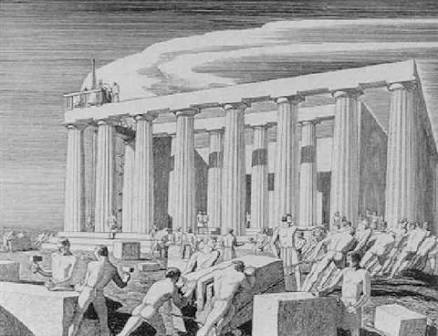History & Engineering: How Athenians Built Their Parthenon In Just 15 Years.
Shrine to a goddess of wisdom
.jpg)
The Goddess' ivory skin glowed softly in the half-light of the temple's inner room. Her magnificent frame stood 33 ft tall, the masterpiece of the Greek sculptor Pheidias. She was Athena, the patron of Athens and goddess of wisdom and the arts, and the building in which she stood was the heart of Athens' Parthenon temple. The building contained two chambers- one a treasury in which offering s were laid, the other housing the statue.
The building of a shrine as a thank-offering to Athena had first been put forward after the Battle of Marathon in 490 BC, when the Greeks won a surprise victory over the invading Persians. But only the platform had been laid before the Persians attacked again, demolishing what there was of the new temple before they were driven back once more. In around 447 BC the project was resumed.
The temple was the brainchild of Pericles, ruler of Athens from 443 to 429 BC, and was intended to symbolise the city's power. But as the building rose on the summit of the Acropolis, the hilltop that dominates Athens, it became a focus of scandal.
Mountain Rock
Marble for the Parthenon is cut in a quarry high ob Mount Pentelicon, 16 km from Athens. With mallets and chisels, workmen carve sockets for wedges to split stone blocks from the bedrock.
Ready for Delivery
At the mountain's foot, men transfer the block from its sledge onto wooden rollers, and ease it from the end of a specially built ramp onto a sturdy cart waiting below. Workers dismantle the sledge before returning it to the quarry.
Skilled Labour
At the foot of the deep quarry, masons rough-hew the blocks to near their final shape. One block has been hauled to the top using pulleys. Workers pull ropes attached to giant winches, turning drums that hoist the block up the mountainside to the top of a causeway.
Precious Cargo and Animal Power
Little by little, the rounded block on its wooden sledge is lowered down the stone causeway. Ropes attached to the block and the sledge are tied to staves hammered into holes at the side of the slipway to prevent the block sliding out of control down the slope. It will form the capital of one of the 42 pillars in the Parthenon's stately colonnade. A straining team of mules pulls the massive block through the outskirts of Athens. The rising Parthenon is visible on the distant Acropolis.
Preparations
A craftsman bores a central hole in a block intended to be the capital of a column. A wooden peg through the hole will line it up with column's other blocks. He has already carved the first 2 inches of fluting, the rest will be done when the pillar is in position.
Marble Pillars
The colonnade was built before the temple inside. Each column was made up of ten or more stacked blocks of marble, levelled by a plumb line. Separate teams of masons worked on each column, so they rose at different speeds. Workers have attached a new block to the bottom of a pulley ready to be hauled to the top of a column.
Clandestine liasons, stolen gold
Pheidias, who was also the temple's chief architect, was accused of arranging assignations for Pericles with unmarried women visiting the site. Later, Pheidias was falsely charged with stealing gols meant for Athena's statue and was put in prison.
Overseeing the building was a committee of five, who dealt with contracts for the sculptors, stonemasons, scaffolders, carpenters, metalworkers and other craftsmen, many of them travelling artisans. The team working on the building was fairly small, perhaps just 200 at any one time.
Carved from mountain rock
The temple was built almost entirely from white marble; only the doors and ceilings were made of timber. Some 22,000 tons of the stone were transported from nearby Mount Pentelicon. Once it was on site, the stonemasons dressed the blocks- already cut close to their finished shapes- so that they could be positioned. They used iron chisels, saw, drills, callipers, set squares and plumb lines. Because no mortar was used, the surfaces where two blocks met had to be a perfect fit. The masons flattened only the outer rim of the face of each block where it joined its neighbour, and left a rougher hollowed surface on the inner section- avoiding contact with the adjoining block. The blocks were clamped together with iron clamps set in lead.
The builders constructed a large flat base with three steps leading up to it, measuring 228 by 101 ft on the top step. Next they raised a colonnade around the edge- 17 pillars on each side and eight at either end. In the center they built the two room inner temple, with six columns at each end.
Gilded Goddess
Athena, the temple deity, towers over workmen applying pure gold to her vast marble dress. Over a ton of gold was used, and the statue cost twice as much to create as the rest of the Parthenon.
Religious Carving
Giant tongs lift the final section of marble for the great frieze on the Parthenon's inner temple depicting a procession in Athena's honour. Sculptors perched high on scaffolding are busily carving the frieze.
Rooftop Statues
A section of one of the Parthenon's two marvle pediments is lowered into position. The pediments will contain statues: those at the temple's eastern end represent Athena's birth, those at the western end show Poseidon, god of the sea, vying with Athena for the right to protect Attica, the region containing Athens.
Finishing Touches
A mason carves the fluting in one of the columns. He uses plumb lines hung from the top to ensure that the vertical lines match exactly with those already carved around the base.
.jpg)
Scenes of siege and battle
Before the roof was added, labourers put 92 carved panels depicting siege and battle scenes from Greek mythology above the colonnade, each panel measuring 4 ft square. They were carved at ground level and then hoisted up on pulleys and positioned. The roof was of sturdy timber, covered with tiles hand-carved from the white marble from the island of Paros were laid over it. By 432 BC the Parthenon was complete and it remained in good condition for 700 years. Its crumbling appearance today is the result of war rather than decay. In the 5th century AD Athena's statue was carried off to Constantinople, and in the 7th century the temple became a Christian church under the Byzantines. It was made into a mosque in 1460 under the Ottoman Turks. in 1687 the Turks, besieged by a Venetian army, used it as an ammunition store. Venetian shelling exploded a powder magazine, shattering columns and walls.

.jpg)
.jpg)
Isnt Europa a goddess in the greek mythology as well?
Hi All :)) I hope your steemit life is good :)
@iknowhow
I'm always astounded at the marvels they eye built so many centuries ago without the technology of today. Yet I appreciate the technology that replaces the man power needed to build today's structures. Wow. Thanks for sharing
Congratulations @iknowhow! You have completed some achievement on Steemit and have been rewarded with new badge(s) :
Click on any badge to view your own Board of Honor on SteemitBoard.
For more information about SteemitBoard, click here
If you no longer want to receive notifications, reply to this comment with the word
STOPthank you for this informative blog.